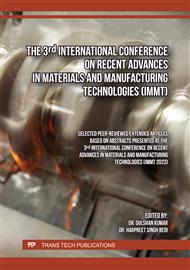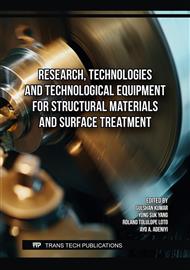p.3
p.11
p.19
p.31
p.41
p.57
p.67
p.79
Experimental Investigation on the Mechanical Properties and Formability Analysis of Stainless Steel 316 Thin Sheets at Different Annealing Temperatures
Abstract:
Microforming holds great importance due to the rising demand for miniaturized parts across diverse industries. It enables the efficient mass production of small-scale components using sheet metals. By exploring microforming processes, researchers can uncover the unique challenges and opportunities associated with manufacturing at the microscale. This research work investigates the impact of temperatures during the annealing on the mechanical properties, microstructural behaviour and formability of austenitic stainless steel 316 thin sheets. The thin sheet, with a thickness of 50µm was considered for the present analysis and were annealed at temperatures ranging from 400 to 1000°C for 30 minutes. Tensile tests were performed and mechanical properties were evaluated at various annealing temperatures. It was witnessed that as the temperature of annealing increases, the ultimate tensile strength reduces and ductility enhances. Erichsen cupping tests were conducted to assess the formability, measuring the dome height of the drawn cups. The results revealed that the as-received thin sheet exhibited poor formability. However, increasing the annealing temperature resulted in enhancing the formability, as evidenced by an increase in the dome height of the drawn cups. Furthermore, the annealing process led to an increase in grain size, which in turn inversely affected the material strength. Therefore, annealing not only enhanced formability but also influenced the microstructural characteristics of the stainless steel 316 foils. Fractography studies were done and the results show that higher annealing temperatures result in ductile fracture, which is favorable for practical applications. At lower temperatures, brittle fracture occurs with the presence of river markings. The present work helps in selecting appropriate annealing conditions for improved toughness and resistance to sudden failure in micro parts.
Info:
Periodical:
Pages:
11-18
Citation:
Online since:
May 2025
Authors:
Keywords:
Price:
Сopyright:
© 2025 Trans Tech Publications Ltd. All Rights Reserved
Share:
Citation:



